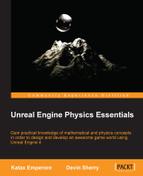In this chapter, we discussed how collision works and how it is implemented in Unreal Engine 4 by first analyzing the topics of trace and collision responses. We also discussed how these responses work, their parameter values, and how to implement these responses to our blueprint assets in detail.
Next, you learned about simple and complex collisions by defining what each type is and how they are used. We also looked at its pros and cons and how to generate the different types of simple collision.
Additionally, you learned more about complex collisions and how to generate these types of collisions in Unreal Engine 4. You also looked at how to create custom collision hulls in third-party art programs.
Furthermore, you learned about collision interactions. We used the First Person Projectile blueprint as an example of how these interactions are used when it comes to scripting different behaviors for our assets.
Moreover, we went through the purposes of custom objects and trace channels. We discussed how to create custom collision presets, including how to implement these customized parameters in blueprints.
Lastly, we discussed the different collision presets that exist in Unreal Engine 4, their purposes, and how they function in detail.
Now that we have a stronger understanding of how collision works and how to implement the different collisions for our assets, we can now dive deep into creating constraints in Unreal Engine 4.
